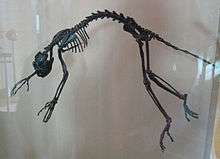Notharctus
| Notharctus Temporal range: Middle Eocene–Late Eocene | |
|---|---|
 | |
| Notharctus tenebrosus | |
| Scientific classification | |
| Kingdom: | Animalia |
| Phylum: | Chordata |
| Clade: | Synapsida |
| Class: | Mammalia |
| Order: | Primates |
| Suborder: | Strepsirrhini |
| Family: | †Notharctidae |
| Subfamily: | †Notharctinae |
| Genus: | †Notharctus Leidy, 1870 |
| Species | |
| |
Notharctus is a genus of adapiform primate that lived in North America during the late to middle Eocene.[1]
The body form of Notharctus is similar to that of modern lemurs. Its fingers were elongated for clamping onto branches, including the development of a thumb. Its spine is flexible and the animal was about 40 centimetres (16 in) in length, excluding the long tail.[2]
There were at least four different Notharctus species.[1] Fossils from at least seven other potential species have also been discovered.
Notharctus osborni skull
References
Literature cited
- Gebo, D.L. (2002). "Adapiformes: Phylogeny and adaptation". In Hartwig, W.C. The Primate Fossil Record. Cambridge University Press. ISBN 978-0-521-08141-2. OCLC 47254191.
External links
This article is issued from Wikipedia - version of the 5/20/2016. The text is available under the Creative Commons Attribution/Share Alike but additional terms may apply for the media files.